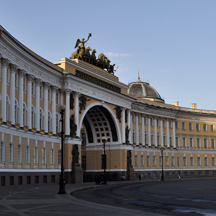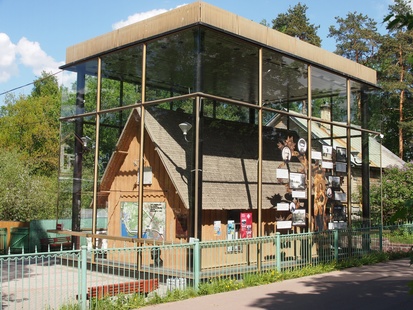
The European Biennial of Contemporary Art
28 June 31 October 2014
St. Petersburg, Russia The State Hermitage Museum
Ilya Orlov & Natasha Kraevskaya

Ilya Orlov and Natasha Kraevskaya, A Revolutionary Museum After Ideology, 2014
photo: Museum “Sarai” (the Shed), Historical cultural museum complex, Razliv village, Sestroretsk.
© Historical cultural museum complex, Razliv, 2013
Ilya Orlov:
Born 1973 in Leningrad, USSR
Lives and works in St Petersburg, Russia
Natasha Kraevskaya:
Born 1972 in Leningrad, USSR
Lives and works in St Petersburg, Russia
A Revolutionary Museum After Ideology, 2014
Site-specific exhibition
June 26 - October 31
The Razliv Museum was built into the countryside shed and forest shelter where Lenin hid during the summer of 1917. Orlov and Kraevskaya’s context-responsive exhibition on the site deconstructs the politics and rituals of commemoration, illuminating and interpreting the “adventures of Soviet ideology in the post-Soviet period” in addition to contemporary ideological means and ambitions of erasing historical memory.
The exhibition includes five lecture-excursions with invited historians, artists, and thinkers on various aspects of the museum after ideology and the politics of memory.
June 29, September 21
Ilya Budraitskis
De-ideologization: Revolutionary Museums and Their Place in the Present (in English)
5 July
Ilya Orlov Mimesis and Revolution: Artistic strategies in “Lenin's last underground” (in Russian)
July 27th
Alexander M. Semyonov Empire and Revolution (in English)
Every trip starts 10.45-15.30, with picnic on site, (costs not included)
Seats are limited. Pre-registration is required. To register, please, send an email with your name, preferred date and with the subject "Razliv" to: rsvp@manifesta.org
Ilya Orlov graduated from the Faculty of Liberal Arts and Sciences (a partnership of St. Petersburg State University and Bard College, NY), where he majored in history, philosophy, and political science. His B.A. graduate work focused on revolutionary mourning rituals in 1917, and he authored an M.A. thesis on aesthetics of nature and issues of landscape in contemporary curatorial studies. Orlov addresses artistic practice from the standpoint of interdisciplinary humanities, critical theory and neo-conceptual approaches. Orlov entered the art scene in the late 2000s and early 2010s. His work offers an analysis of social, urban, and environmental issues of post-Soviet reality and has been shown in several solo exhibitions—Obvodny Canal (2009), City Maps (2011), A Song of Gentrification (2012), Untitled (2013)—as well as in museum and group shows, such as a special project at the Moscow Biennale of Contemporary Art (2011).
Natasha Kraevskaya, is known for her papier-mâché and concrete sculptures, objects, and acrylic painting that combine a neo-Pop-art approach with trash art and Arte Povera strategies, Natasha Kraevskaya explores a common person’s desire for beauty shaped by the economic and cultural conditions of a post-socialist reality. Kraevskaya’s works are often humorous and provoke a double take by viewers, causing them to both smile and think. The artist’s career has included several solo exhibitions such as Chain Link (2010), Pussy or Impossible Beauty (2006), and Chic (2005), as well as inclusion in museum exhibitions and collective projects.






